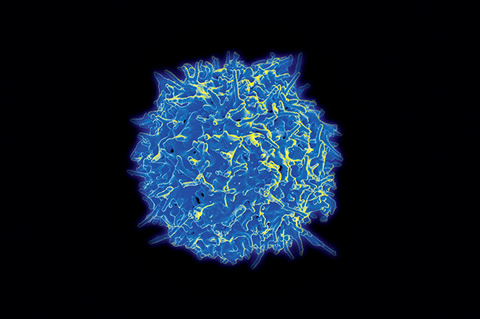The exact locations of proteins in a cell have been recorded in unprecedented detail as part of a “protein map” developed by U of T scientists. The new map allows researchers to understand in greater detail what happens in a cell when disease strikes. Because more and more drugs work by blocking or stimulating individual proteins, the map will also help scientists determine better treatments.
Proteins, which are products of genes, are responsible for all the workings of a cell. When the cell receives a signal, such as to “grow,” “divide,” or “stop dividing,” proteins move around within the cell.
But scientists previously knew very little about how these protein movements occur. “It’s really important to understand how that happens if we’re going to be able to understand why cells are healthy and why they’re sometimes diseased,” says researcher Brenda Andrews, who led the study with Jason Moffatt and Charles Boone, all professors at the Donnelly Centre for Cellular and Biomolecular Research.
The new map, which charts the movements and abundance of roughly 3,000 proteins in a yeast cell, is the result of a massive, decade-long study. The researchers collected data for a mind-boggling 20 million cells and worked closely with robotic engineers, who built machines to manipulate the cells and create images of them. The team also worked with software writers, who designed artificial intelligence-based algorithms to process the vast amount of data.
“The reason we need to do it on a large scale is because there simply are so many proteins,” says Andrews.
Yeast cells work in very similar ways to human cells but have fewer proteins – around a quarter the number that exist in more complex human cells. This relative simplicity has allowed researchers such as Andrews and Boone to use yeast to gain many fundamental insights into how both yeast and human cells work.
Their team tagged proteins with a fluorescent marker so they could locate them within different parts of a cell. Then they charted protein movement and abundance in normal cells, and looked at what happens when cells carry a mutation, which could lead to a genetic disease, for example, or when cells are exposed to different drugs.
“We’ve developed methods that allow scientists to examine all of the proteins in a cell and how they change in response to any kind of perturbation,” says Andrews.
Next, the researchers will use this powerful tool to investigate how proteins move in human cells, such as cancer cells, to learn more about how the disease starts, but also to search for new treatments.
By comparing the locations and movements of proteins in healthy cells with the location and movements of proteins in diseased cells, scientists hope to learn what’s different and, ultimately, determine how to prevent the change from occurring.
A detailed database of protein locations was made available in June through G3: Genes | Genomes | Genetics, the official journal of the Genetics Society of America, so that any scientist can look up the location and movement of proteins they’re interested in.
Watch a video about the protein map developed by researchers at
U of T’s Donnelly Centre





